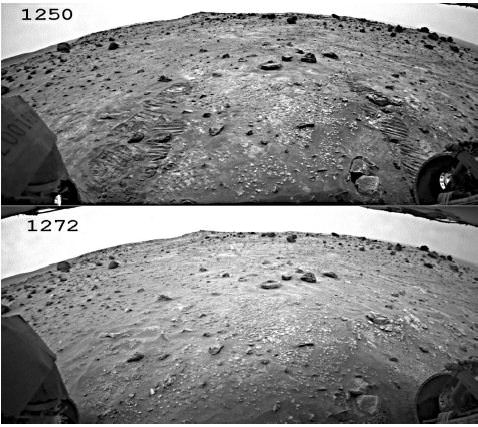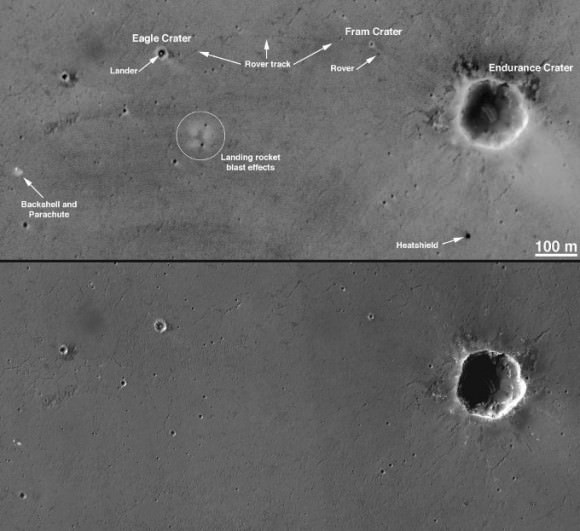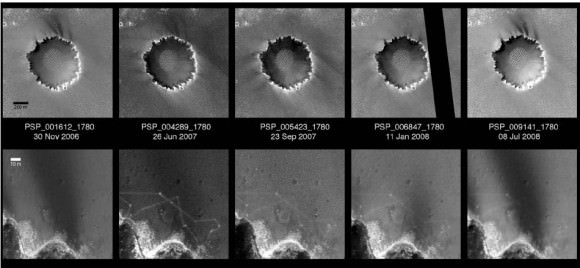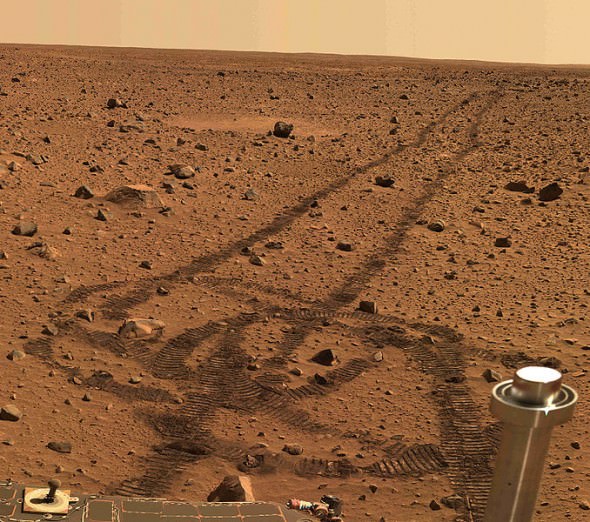[/caption]
The footprints and rover tracks on the Moon will be there for millions of years, as there is no wind to blow them away. But Mars is a different story. Researchers looking at the tracks left by the two Mars Exploration Rovers, Spirit and Opportunity have found that Mars wind storms can quickly erase any evidence the rovers had been there.
“It is humbling, said Paul Geissler, lead author of a recent paper on eolian — or wind — processes on Mars. “We make kilometer-long human graffiti on the surface of another planet and then Mars just wipes the slate clean for the next visitors!”

Geissler and his team were interested in how the Martian wind affects the surface, in the mechanisms and time-scales for the surface changes that could be seen across the globe.
Each of the rovers have left a trail of tracks in the soil that could be seen by orbiting spacecraft – the Mars Global Surveyor (no longer functioning) and the Mars Reconnaissance Orbiter – as well as in images from the rovers themselves.
From the images, the team was able to document the formation of the tracks and also their eventual erasure through the action of Martian winds.
They were a little surprised at the results.
“We anticipated that we would be able to see the rovers’ tracks in MRO HiRISE images and we *might* see some changes,” Geissler told Universe Today in an email, “ but I was surprised at how quickly the tracks disappeared!”
Geissler said that when he wrote his original proposal for the research (which was before MRO arrived at Mars), he thought it was likely they would not see any changes in the tracks over the duration of the mission.

“I expected the tracks to be slowly buried by dust settling out of the atmosphere or overprinted by dust-devils in Gusev crater,” he said. “Instead they are blown away by gusts of wind during episodic storms that only last a few days! I think the mechanisms of track erasure are interesting and somewhat surprising.”
While it might be sad for most of us to know the rover tracks are being erased, the scientists see it a little differently.
“I will confess to not feeling sad about it at all,” said Jim Bell, lead the lead scientist for the Panoramic cameras on the rovers, and a member of the Geissler’s research team. “Rather, it’s cool that the Martian environment is so dynamic, and tracking the tracks provides a neat science experiment to understand the role of dust and sand transport in modifying the current surface. So don’t be sad, be glad!

Read the team’s paper: “Gone with the wind: Eolian erasure of the Mars Rover tracks”
Hat tip to Scott Maxwell (@marsroverdriver) on Twitter.


Speaking of tracks, an interplanetary comparison: http://roadtoendeavour.files.wordpress.com/2010/11/tracks2.jpg
Whilst the tracks are temporary, the rock-holes drilled by both rovers should be a good deal more permanent…
The erosional qualities of the soils in transport or liqufiaction must be noted here. Imagine all those little ‘blueberries’ bouncing off your helmet! Uh OH! Dzzz….
Rover forgot to put up the trail markers out of pile of rocks. History lost!
I’m surprised to read about “rocket blasts at Opportunity’s landing site”. I know that Phoenix used retro-rocket firing to land, but I thought Opportunity and Spirit descended by parachute and then bounced in protective inflatables to a standstill. Maybe I’ve been wrong about this?
Buxtehude, you lazy son of a mother 😉 :
“… Rocket assisted descent (RAD) motors: Because the atmospheric density of Mars is less than 1% of Earth’s, the parachute alone could not slow down the Mars Exploration Rover enough to ensure a safe, low landing speed. The spacecraft descent was assisted by rockets that brought the spacecraft to a dead stop 10–15 m (30–50 ft) above the Martian surface.[29]
Radar altimeter unit: A radar altimeter unit was used to determine the distance to the Martian surface. The radar’s antenna is mounted at one of the lower corners of the lander tetrahedron. When the radar measurement showed the lander was the correct distance above the surface, the Zylon bridle was cut, releasing the lander from the parachute and backshell so that it was free and clear for landing. The radar data also enabled the timing sequence on airbag inflation and backshell RAD rocket firing.[29]
Airbags
Airbags used in the Mars Exploration Rover mission are the same type that Mars Pathfinder used in 1997. They had to be strong enough to cushion the spacecraft if it landed on rocks or rough terrain and allow it to bounce across Mars’ surface at freeway speeds after landing. The airbags had to be inflated seconds before touchdown and deflated once safely on the ground. …
Lander
The spacecraft lander is a protective “shell” that houses the rover, and together with the airbags, protects it from the forces of impact.
The lander is a tetrahedron shape, whose sides open like petals. It is strong and light, and made of beams and sheets. The beams consist of layers of graphite fiber woven into a fabric that is lighter than aluminium and more rigid than steel. Titanium fittings are glued and fitted onto the beams to allow it to be bolted together. The rover was held inside the lander by bolts and special nuts that were released after landing with small explosives.
Uprighting
After the lander stopped bouncing and rolling on the ground, it came to rest on the base of the tetrahedron or one of its sides. The sides then opened to make the base horizontal and the rover upright. The sides are connected to the base by hinges, each of which has a motor strong enough to lift the lander.”
The correct claim is: Opportunity and Spirit descended by parachute, fired retrorockets to achieve correct drop altitude, and then bounced, in protective shell, using inflatables to a standstill. Then righted itself when opening the shell.
[Btw, note that Wp uses the same track panorama photo!]
Ooops. Or daughter of a mother. [I profess thinking too much of the stereotypic expression when crafting the pun. Duh!]
Could somebody help me out with this question?
Is there a Mars communicaton black out period? When the earth is on one side on the Sun and Mars is on the other. Any idea how long it lasts?
Take only pictures. Leave only footprints.